The Effect of Integrative Neuromuscular Training on Enhancing Athletic Performance: A Systematic Review and Meta-Analysis
Abstract
1. Introduction
2. Materials and Methods
2.1. Search Strategy
2.2. Inclusion/Exclusion Criteria
2.2.1. Inclusion Criteria
2.2.2. Exclusion Criteria
2.3. Screening of Literature and Data Extraction
2.4. Risk of Bias Assessment
2.5. Data Analysis
3. Results
3.1. Study Selection
3.2. Study Characteristics and Risk of Bias
3.3. Meta-Analysis Results
3.3.1. Pooled Outcomes
3.3.2. Heterogeneity
3.3.3. Sensitivity Analysis
3.3.4. Bias Test
3.3.5. Subgroup Analyses
Subgroup of Jump Performance
Subgroup of Sprint Performance
Subgroup of Agility Performance
Subgroup of Balance Performance
4. Discussion
4.1. Effect of Jump Performance
4.2. Effect of Sprint Performance
4.3. Effect of Agility Performance
4.4. Effect of Balance Performance
5. Conclusions
Author Contributions
Funding
Acknowledgments
Conflicts of Interest
References
- Smith, D.J. A Framework for Understanding the Training Process Leading to Elite Performance. Sports Med. 2003, 33, 1103–1126. [Google Scholar] [CrossRef]
- Kryeziu, A.R.; Iseni, A.; Teodor, D.F.; Croitoru, H.; Badau, D. Effect of 12 Weeks of the Plyometric Training Program Model on Speed and Explosive Strength Abilities in Adolescents. Appl. Sci. 2023, 13, 2776. [Google Scholar] [CrossRef]
- Booth, M.A.; Orr, R. Effects of Plyometric Training on Sports Performance. Strength Cond. J. 2016, 38, 30–37. [Google Scholar] [CrossRef]
- Stojanović, E.; Ristić, V.; McMaster, D.T.; Milanović, Z. Effect of Plyometric Training on Vertical Jump Performance in Female Athletes: A Systematic Review and Meta-Analysis. Sports Med. 2017, 47, 975–986. [Google Scholar] [CrossRef]
- Ide, B.N.; Silvatti, A.P.; Marocolo, M.; Santos, C.P.C.; Silva, B.V.C.; Oranchuk, D.J.; Mota, G.R. Is There Any Non-Functional Training? A Conceptual Review. Front. Sports Act. Living 2022, 3, 803366. [Google Scholar] [CrossRef]
- Ide, B.N.; Marocolo, M.; Santos, C.P.C.; Silva, B.V.C.; Silvatti, A.P.; Simim, M.A.M.; Oranchuk, D.J.; De Agostini, G.G.; Mota, G.R. Commentary: “You’re Only as Strong as Your Weakest Link”: A Current Opinion about the Concepts and Characteristics of Functional Training. Front. Physiol. 2021, 12, 744144. [Google Scholar] [CrossRef]
- Friedmann-Bette, B.; Bauer, T.; Kinscherf, R.; Vorwald, S.; Klute, K.; Bischoff, D.; Müller, H.; Weber, M.-A.; Metz, J.; Kauczor, H.-U.; et al. Effects of Strength Training with Eccentric Overload on Muscle Adaptation in Male Athletes. Eur. J. Appl. Physiol. 2010, 108, 821–836. [Google Scholar] [CrossRef]
- Liu, Y.; Zhang, J.; Hu, Z.; Zhong, Z.; Yuan, X. Acute Effects of Eccentric Overload Training with Different Loading Doses in Male Sprinters. Heliyon 2024, 10, e32369. [Google Scholar] [CrossRef]
- Wang, X.; Zhai, H.; Wei, H. Acute Effects of Different Intensities of Flywheel Half Squat Based on Velocity on Vertical Jump Performance in High-Level Athletes. Appl. Sci. 2025, 15, 4388. [Google Scholar] [CrossRef]
- Lundby, C.; Millet, G.P.; Calbet, J.A.; Bärtsch, P.; Subudhi, A.W. Does ‘Altitude Training’ Increase Exercise Performance in Elite Athletes? Br. J. Sports Med. 2012, 46, 792–795. [Google Scholar] [CrossRef]
- Deng, L.; Liu, Y.; Chen, B.; Hou, J.; Liu, A.; Yuan, X. Impact of Altitude Training on Athletes’ Aerobic Capacity: A Systematic Review and Meta-Analysis. Life 2025, 15, 305. [Google Scholar] [CrossRef] [PubMed]
- Myer, G.D.; Faigenbaum, A.D.; Ford, K.R.; Best, T.M.; Bergeron, M.F.; Hewett, T.E. When to Initiate Integrative Neuromuscular Training to Reduce Sports-Related Injuries and Enhance Health in Youth? Curr. Sports Med. Rep. 2011, 10, 155–166. [Google Scholar] [CrossRef] [PubMed]
- Fort-Vanmeerhaeghe, A.; Romero-Rodriguez, D.; Lloyd, R.S.; Kushner, A.; Myer, G.D. Integrative Neuromuscular Training in Youth Athletes. Part II: Strategies to Prevent Injuries and Improve Performance. Strength Cond. J. 2016, 38, 9–27. [Google Scholar] [CrossRef]
- Hewett, T.E.; Myer, G.D.; Ford, K.R.; Heidt, R.S., Jr.; Colosimo, A.J.; McLean, S.G.; van den Bogert, A.J.; Paterno, M.V.; Succop, P. Biomechanical Measures of Neuromuscular Control and Valgus Loading of the Knee Predict Anterior Cruciate Ligament Injury Risk in Female Athletes. Am. J. Sports Med. 2005, 33, 492–501. [Google Scholar] [CrossRef]
- Faigenbaum, A.D.; Bush, J.A.; McLoone, R.P.; Kreckel, M.C.; Farrell, A.; Ratamess, N.A.; Kang, J. Benefits of Strength and Skill-Based Training during Primary School Physical Education. J. Strength Cond. Res. 2015, 29, 1255–1262. [Google Scholar] [CrossRef]
- Noyes, F.R.; Barber-Westin, S.D.; Tutalo Smith, S.T.; Campbell, T. A Training Program to Improve Neuromuscular and Performance Indices in Female High School Soccer Players. J. Strength Cond. Res. 2013, 27, 340–351. [Google Scholar] [CrossRef]
- Ratamess, N.A.; Alvar, B.A.; Evetoch, T.K.; Housh, T.J.; Kibler, W.B.; Kraemer, W.J.; Triplett, N.T.; American College of Sports Medicine. Progression Models in Resistance Training for Healthy Adults. Med. Sci. Sports Exerc. 2009, 41, 687–708. [Google Scholar] [CrossRef]
- Fernandez-Fernandez, J.; Granacher, U.; Sanz-Rivas, D.; Sarabia Marín, J.M.; Hernandez-Davo, J.L.; Moya, M. Sequencing Effects of Neuromuscular Training on Physical Fitness in Youth Elite Tennis Players. J. Strength Cond. Res. 2018, 32, 849–856. [Google Scholar] [CrossRef]
- Gavala, M.; Bassa, E.; Zetou, E.; Smilios, I.; Douda, H. Effect of Integrative Neuromuscular Training and Detraining on Performance Indices in Young Female Volleyball Players. J. Sports Med. Phys. Fit. 2023, 63, 1285–1294. [Google Scholar] [CrossRef]
- Panagoulis, C.; Chatzinikolaou, A.; Avloniti, A.; Leontsini, D.; Deli, C.K.; Draganidis, D.; Stampoulis, T.; Oikonomou, T.; Papanikolaou, K.; Rafailakis, L.; et al. In-Season Integrative Neuromuscular Strength Training Improves Performance of Early-Adolescent Soccer Athletes. J. Strength Cond. Res. 2020, 34, 516–526. [Google Scholar] [CrossRef]
- Hammami, R.; Negra, Y.; Nebigh, A.; Ramirez-Campillo, R.; Moran, J.; Chaabene, H. Preseason Integrative Neuromuscular Training Improves Selected Measures of Physical Fitness in Highly Trained, Youth, Male Soccer Players. J. Strength Cond. Res. 2023, 37, e384–e390. [Google Scholar] [CrossRef] [PubMed]
- Xiong, J.; Li, S.; Cao, A.; Qian, L.; Peng, B.; Xiao, D. Effects of Integrative Neuromuscular Training Intervention on Physical Performance in Elite Female Table Tennis Players: A Randomized Controlled Trial. PLoS ONE 2022, 17, e0262775. [Google Scholar] [CrossRef] [PubMed]
- Mainer-Pardos, E.; Villavicencio Álvarez, V.E.; Moreno-Apellaniz, N.; Gutiérrez-Logroño, A.; Calero-Morales, S. Effects of a Neuromuscular Training Program on the Performance and Inter-Limb Asymmetries in Highly Trained Junior Male Tennis Players. Heliyon 2024, 10, e27081. [Google Scholar] [CrossRef] [PubMed]
- Nasser, M. New Standards for Systematic Reviews Incorporate Population Health Sciences. Am. J. Public Health 2020, 110, 753–754. [Google Scholar] [CrossRef]
- Williams, M.D.; Hammond, A.; Moran, J. Beyond Athletic Development: The Effects of Parkour-Based versus Conventional Neuromuscular Exercises in Pre-Adolescent Basketball Players. PLoS ONE 2023, 18, e0288439. [Google Scholar] [CrossRef]
- Roso-Moliner, A.; Mainer-Pardos, E.; Cartón-Llorente, A.; Nobari, H.; Pettersen, S.A.; Lozano, D. Effects of a Neuromuscular Training Program on Physical Performance and Asymmetries in Female Soccer. Front. Physiol. 2023, 14, 1171636. [Google Scholar] [CrossRef]
- Arede, J.; Fernandes, J.; Moran, J.; Leite, N.; Romero-Rodriguez, D.; Madruga-Parera, M. Effects of an Integrative Neuromuscular Training Protocol vs. FIFA 11+ on Sprint, Change of Direction Performance and Inter-Limb Asymmetries in Young Soccer Players. Int. J. Sports Sci. Coach. 2022, 17, 54–62. [Google Scholar] [CrossRef]
- Filipa, A.; Byrnes, R.; Paterno, M.V.; Myer, G.D.; Hewett, T.E. Neuromuscular Training Improves Performance on the Star Excursion Balance Test in Young Female Athletes. J. Orthop. Sports Phys. Ther. 2010, 40, 551–558. [Google Scholar] [CrossRef]
- Italo, S.; Giacomo, C.; Rosario, D.O. The Effects of 8 Weeks of Integrative Neuromuscular Pitch Training on Strength Values and Sprint Performance in Young Élite Soccer Players. J. Phys. Educ. Sport 2023, 23, 909–917. [Google Scholar]
- Emirzeoğlu, M.; Ülger, Ö. The Acute Effects of Cognitive-Based Neuromuscular Training and Game-Based Training on the Dynamic Balance and Speed Performance of Healthy Young Soccer Players: A Randomized Controlled Trial. Games Health J. 2021, 10, 121–129. [Google Scholar] [CrossRef]
- Fernandez-Fernandez, J.; García-Tormo, V.; Santos-Rosa, F.J.; Teixeira, A.S.; Nakamura, F.Y.; Granacher, U.; Sanz-Rivas, D. The Effect of a Neuromuscular vs. Dynamic Warm-up on Physical Performance in Young Tennis Players. J. Strength Cond. Res. 2020, 34, 2776–2784. [Google Scholar] [CrossRef] [PubMed]
- Michailidis, Y.; Kyzerakos, T.; Metaxas, T.I. The Effect of Integrative Training Program on Youth Soccer Players’ Power Indexes. Appl. Sci. 2023, 14, 384. [Google Scholar] [CrossRef]
- Zhang, M.; Ma, H.; Liu, Z.; Smith, D.M.; Wang, X. The Effects of a 10-Week Neuromuscular Training on Postural Control in Elite Youth Competitive Ballroom Dancers: A Randomized Controlled Trial. Front. Physiol. 2021, 12, 636209. [Google Scholar] [CrossRef] [PubMed]
- Zech, A.; Klahn, P.; Hoeft, J.; Zu Eulenburg, C.; Steib, S. Time Course and Dimensions of Postural Control Changes Following Neuromuscular Training in Youth Field Hockey Athletes. Eur. J. Appl. Physiol. 2014, 114, 395–403. [Google Scholar] [CrossRef] [PubMed]
- Gee, T.I.; Morrow, R.A.; Stone, M.R.; Bishop, D.C. A Neuromuscular Training Program Enhances Dynamic Neuromuscular Control and Physical Performance in Court-sport Athletes. Transl. Sports Med. 2020, 3, 9–15. [Google Scholar] [CrossRef]
- Steffen, K.; Emery, C.A.; Romiti, M.; Kang, J.; Bizzini, M.; Dvorak, J.; Finch, C.F.; Meeuwisse, W.H. High Adherence to a Neuromuscular Injury Prevention Programme (FIFA 11+) Improves Functional Balance and Reduces Injury Risk in Canadian Youth Female Football Players: A Cluster Randomised Trial. Br. J. Sports Med. 2013, 47, 794–802. [Google Scholar] [CrossRef]
- Bonato, M.; Benis, R.; La Torre, A. Neuromuscular Training Reduces Lower Limb Injuries in Elite Female Basketball Players. A Cluster Randomized Controlled Trial. Scand. Med. Sci. Sports 2018, 28, 1451–1460. [Google Scholar] [CrossRef]
- Benis, R.; Bonato, M.; Torre, A.L. Elite Female Basketball Players’ Body-Weight Neuromuscular Training and Performance on the Y-Balance Test. J. Athl. Train. 2016, 51, 688–695. [Google Scholar] [CrossRef]
- Ayala, F.; Pomares-Noguera, C.; Robles-Palazón, F.; Del Pilar García-Vaquero, M.; Ruiz-Pérez, I.; Hernández-Sánchez, S.; De Ste Croix, M. Training Effects of the FIFA 11+ and Harmoknee on Several Neuromuscular Parameters of Physical Performance Measures. Int. J. Sports Med. 2017, 38, 278–289. [Google Scholar] [CrossRef]
- Makaruk, H.; Starzak, M.; Tarkowski, P.; Sadowski, J.; Winchester, J. The Effects of Resistance Training on Sport-Specific Performance of Elite Athletes: A Systematic Review with Meta-Analysis. J. Hum. Kinet. 2024, 91, 135–155. [Google Scholar] [CrossRef]
- Liao, K.-F.; Nassis, G.; Bishop, C.; Yang, W.; Bian, C.; Li, Y.-M. Effects of Unilateral vs. Bilateral Resistance Training Interventions on Measures of Strength, Jump, Linear and Change of Direction Speed: A Systematic Review and Meta-Analysis. Biol. Sport 2022, 39, 485–497. [Google Scholar] [CrossRef]
- Steffen, K.; Myklebust, G.; Olsen, O.E.; Holme, I.; Bahr, R. Preventing Injuries in Female Youth Football—A Cluster-randomized Controlled Trial. Scand. Med. Sci. Sports 2008, 18, 605–614. [Google Scholar] [CrossRef]
- Dahab, K.S.; McCambridge, T.M. Strength Training in Children and Adolescents: Raising the Bar for Young Athletes? Sports Health Multidiscip. Approach 2009, 1, 223–226. [Google Scholar] [CrossRef]
- Brown, K.A.; Patel, D.R.; Darmawan, D. Participation in Sports in Relation to Adolescent Growth and Development. Transl. Pediatr. 2017, 6, 150–159. [Google Scholar] [CrossRef] [PubMed]
- Sánchez Pastor, A.; García-Sánchez, C.; Marquina Nieto, M.; De La Rubia, A. Influence of Strength Training Variables on Neuromuscular and Morphological Adaptations in Prepubertal Children: A Systematic Review. Int. J. Environ. Res. Public Health 2023, 20, 4833. [Google Scholar] [CrossRef] [PubMed]
- Fernandez-Fernandez, J.; De Villarreal, E.S.; Sanz-Rivas, D.; Moya, M. The Effects of 8-Week Plyometric Training on Physical Performance in Young Tennis Players. Pediatr. Exerc. Sci. 2016, 28, 77–86. [Google Scholar] [CrossRef] [PubMed]
- Wiegel, P.; Centner, C.; Kurz, A. How Motor Unit Recruitment Speed and Discharge Rates Determine the Rate of Force Development. J. Physiol. 2019, 597, 2331–2332. [Google Scholar] [CrossRef]
- Moritani, T. Neuromuscular Adaptations during the Acquisition of Muscle Strength, Power and Motor Tasks. J. Biomech. 1993, 26, 95–107. [Google Scholar] [CrossRef]
- Lloyd, R.S.; Meyers, R.W.; Oliver, J.L. The Natural Development and Trainability of Plyometric Ability during Childhood. Strength Cond. J. 2011, 33, 23–32. [Google Scholar] [CrossRef]
- Myers, J.B.; Lephart, S.M. The Role of the Sensorimotor System in the Athletic Shoulder. J. Athl. Train. 2000, 35, 351–363. [Google Scholar]
- Guido, J.A.; Stemm, J. Reactive Neuromuscular Training: A Multi-Level Approach to Rehabilitation of the Unstable Shoulder. N. Am. J. Sports Phys. Ther. 2007, 2, 97–103. [Google Scholar]
- Wang, Z.-H.; Pan, R.-C.; Huang, M.-R.; Wang, D. Effects of Integrative Neuromuscular Training Combined with Regular Tennis Training Program on Sprint and Change of Direction of Children. Front. Physiol. 2022, 13, 831248. [Google Scholar] [CrossRef]
- Oliver, J.L.; Lloyd, R.S.; Rumpf, M.C. Developing Speed throughout Childhood and Adolescence: The Role of Growth, Maturation and Training. Strength Cond. J. 2013, 35, 42–48. [Google Scholar] [CrossRef]
- Salo, A.I.T.; Bezodis, I.N.; Batterham, A.M.; Kerwin, D.G. Elite Sprinting: Are Athletes Individually Step-Frequency or Step-Length Reliant? Med. Sci. Sports Exerc. 2011, 43, 1055–1062. [Google Scholar] [CrossRef] [PubMed]
- Hughes, D.C.; Ellefsen, S.; Baar, K. Adaptations to Endurance and Strength Training. Cold Spring Harb. Perspect. Med. 2018, 8, a029769. [Google Scholar] [CrossRef] [PubMed]
- National Strength and Conditioning Association. Essentials of Strength Training and Conditioning; Human Kinetics: Champaign, IL, USA, 2021; ISBN 1-7182-1088-4. [Google Scholar]
- Myer, G.D.; Ford, K.R.; Barber Foss, K.D.; Liu, C.; Nick, T.G.; Hewett, T.E. The Relationship of Hamstrings and Quadriceps Strength to Anterior Cruciate Ligament Injury in Female Athletes. Clin. J. Sport Med. 2009, 19, 3–8. [Google Scholar] [CrossRef] [PubMed]
- El-Ashker, S.; Carson, B.P.; Ayala, F.; De Ste Croix, M. Sex-Related Differences in Joint-Angle-Specific Functional Hamstring-to-Quadriceps Strength Ratios. Knee Surg. Sports Traumatol. Arthrosc. 2017, 25, 949–957. [Google Scholar] [CrossRef]
- Ramos, E.; Frontera, W.; Llopart, A.; Feliciano, D. Muscle Strength and Hormonal Levels in Adolescents: Gender Related Differences. Int. J. Sports Med. 1998, 19, 526–531. [Google Scholar] [CrossRef]
- Chaabene, H.; Prieske, O.; Moran, J.; Negra, Y.; Attia, A.; Granacher, U. Effects of Resistance Training on Change-of-Direction Speed in Youth and Young Physically Active and Athletic Adults: A Systematic Review with Meta-Analysis. Sports Med. 2020, 50, 1483–1499. [Google Scholar] [CrossRef]
- Universidad Pedagógica y Tecnológica de Colombia; Quemba-Joya, D.K. Entrenamiento neuromuscular integrativo como herramienta para optimizar el rendimiento deportivo en diferentes grupos etarios y niveles competitivos. Revisión de literatura. Rev. Digit. Act. Fis. Deport. (En Línea) 2023, 9, e2261. [Google Scholar] [CrossRef]
- Kilding, A.E.; Tunstall, H.; Kuzmic, D. Suitability of FIFA’s “the 11” Training Programme for Young Football Players—Impact on Physical Performance. J. Sports Sci. Med. 2008, 7, 320–326. [Google Scholar]
- Horníková, H.; Zemková, E. The Importance of Core Strength for Change of Direction Speed. Front. Physiol. 2024, 15, 1376422. [Google Scholar] [CrossRef]
- Wan, K.; Dai, Z.; Wong, P.; Ho, R.S.; Tam, B.T. Comparing the Effects of Integrative Neuromuscular Training and Traditional Physical Fitness Training on Physical Performance Outcomes in Young Athletes: A Systematic Review and Meta-Analysis. Sports Med. Open 2025, 11, 15. [Google Scholar] [CrossRef]
- Han, J.; Waddington, G.; Adams, R.; Anson, J.; Liu, Y. Assessing Proprioception: A Critical Review of Methods. J. Sport Health Sci. 2016, 5, 80–90. [Google Scholar] [CrossRef]
- Pletcher, E.R.; Dekker, T.J.; Lephart, S.M.; Sell, T.C. Sex and Age Comparisons in Neuromuscular and Biomechanical Characteristics of the Knee in Young Athletes. Int. J. Sports Phys. Ther. 2021, 16, 438–449. [Google Scholar] [CrossRef]
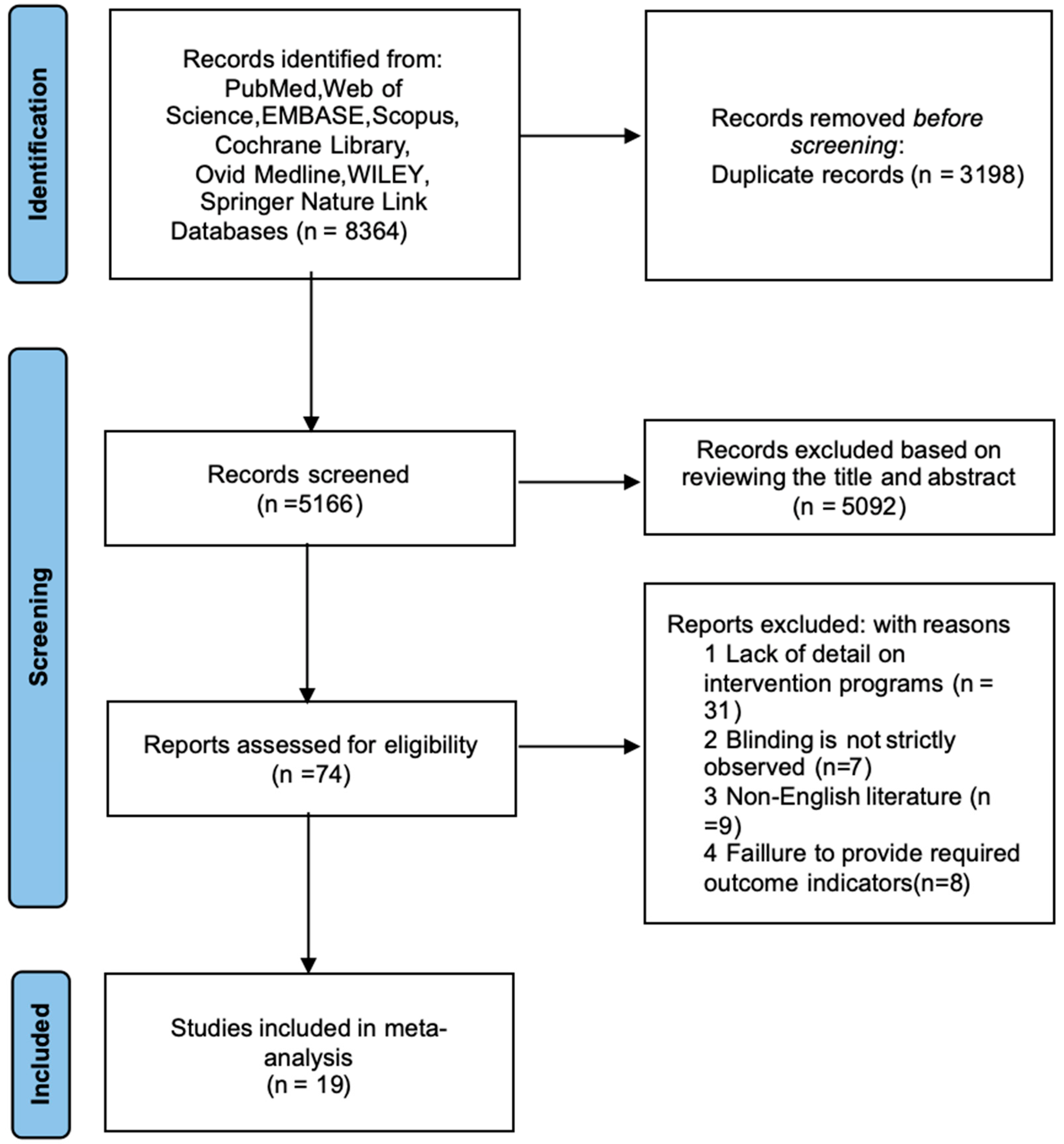



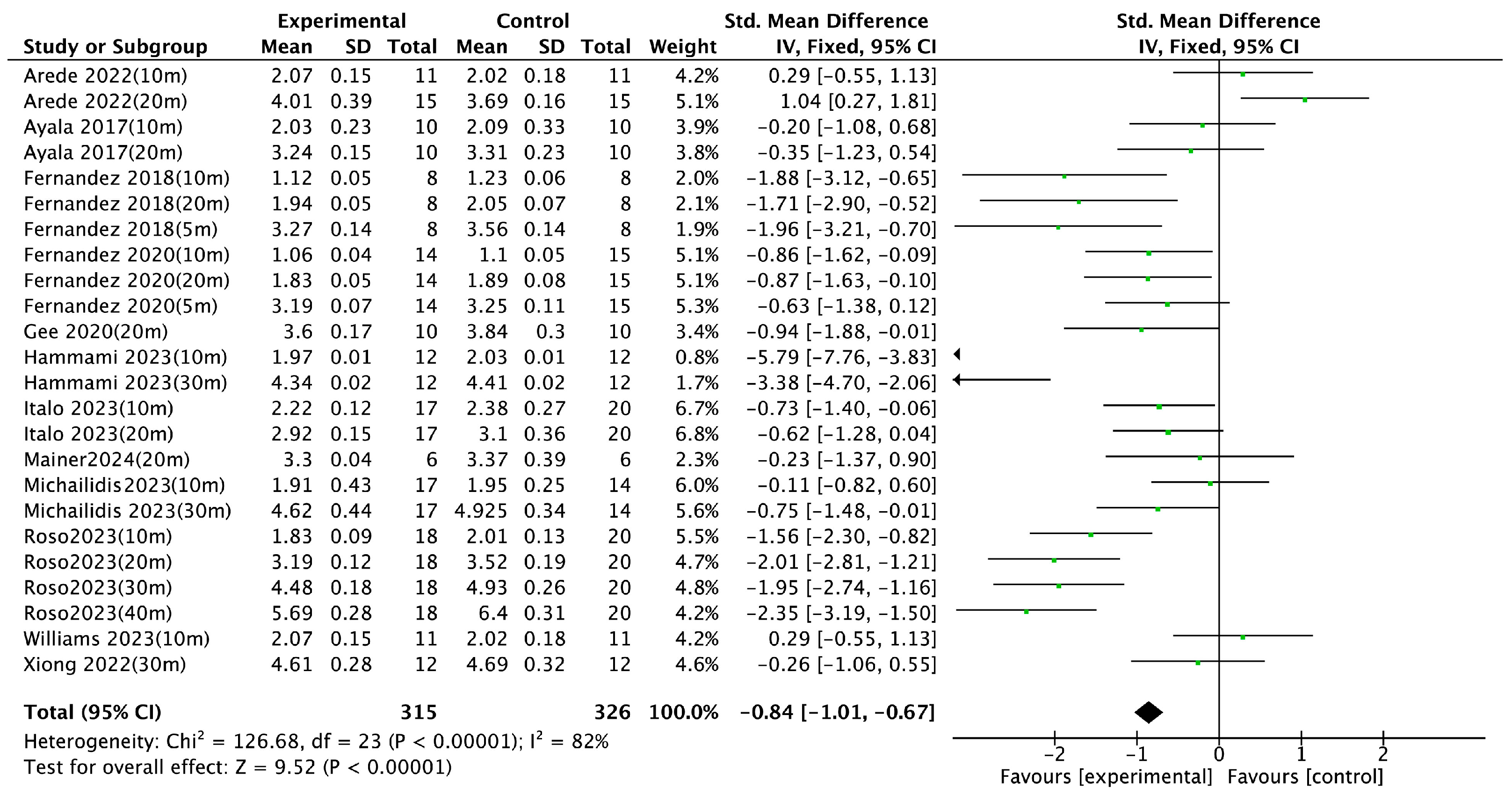


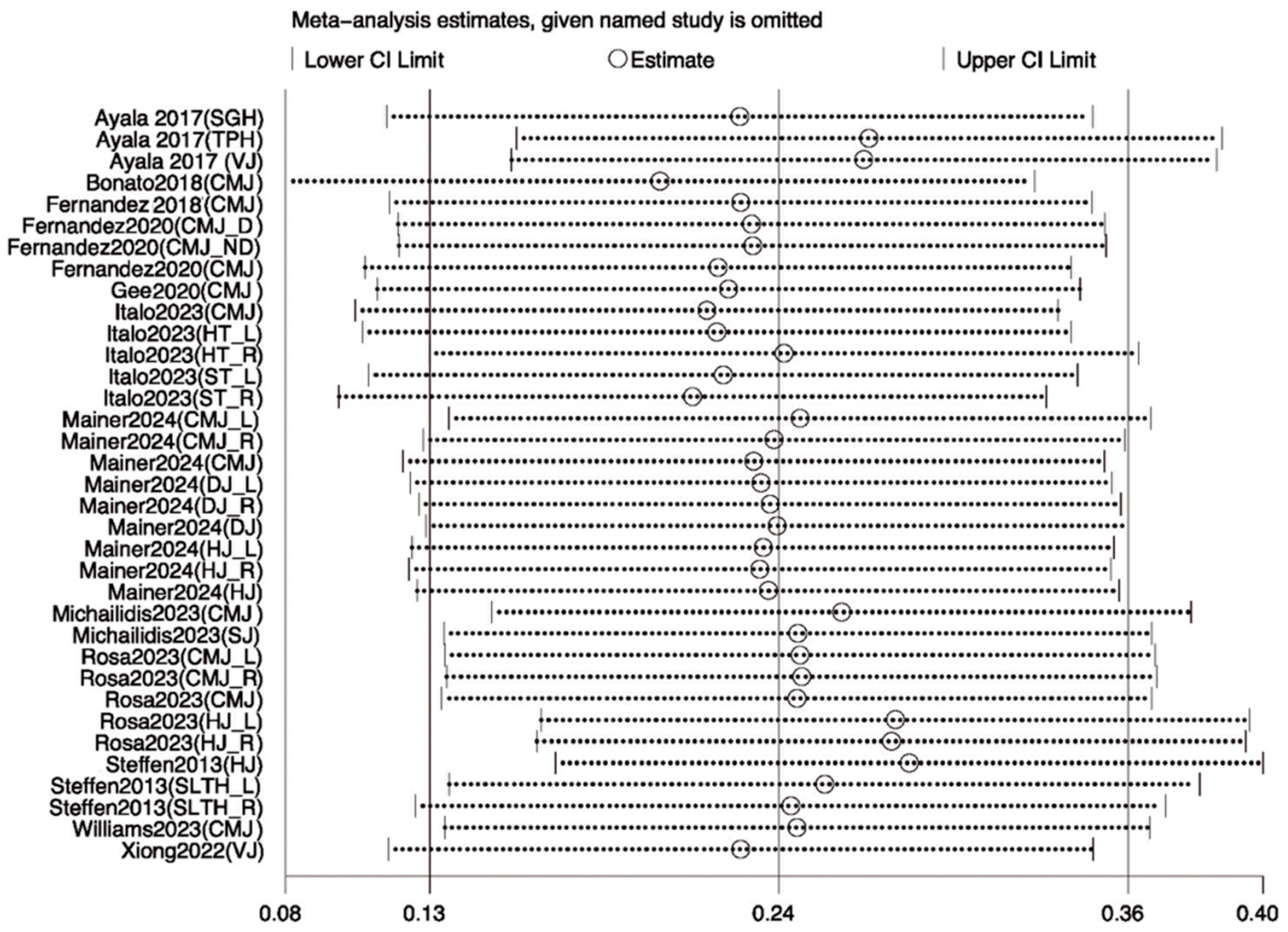

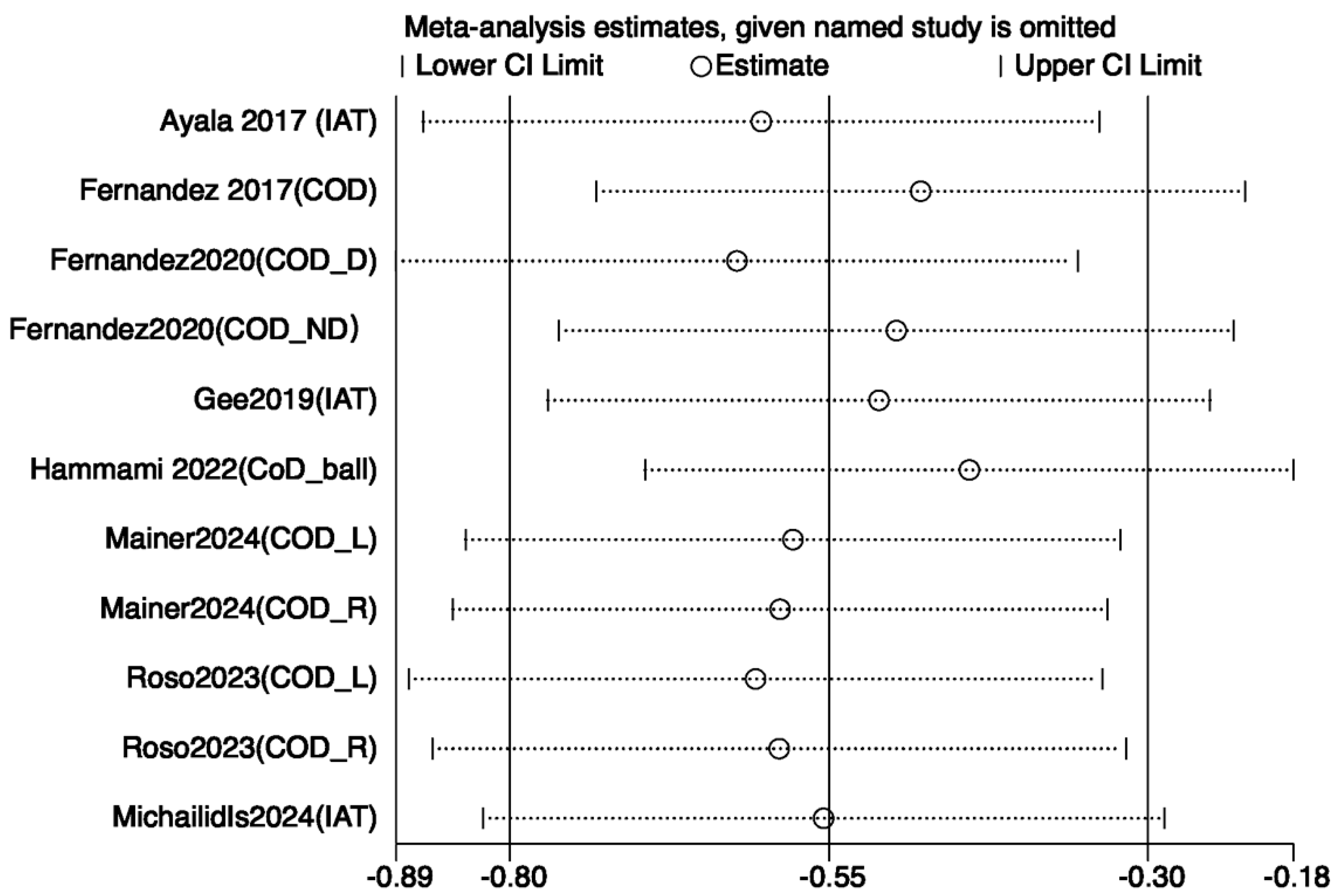
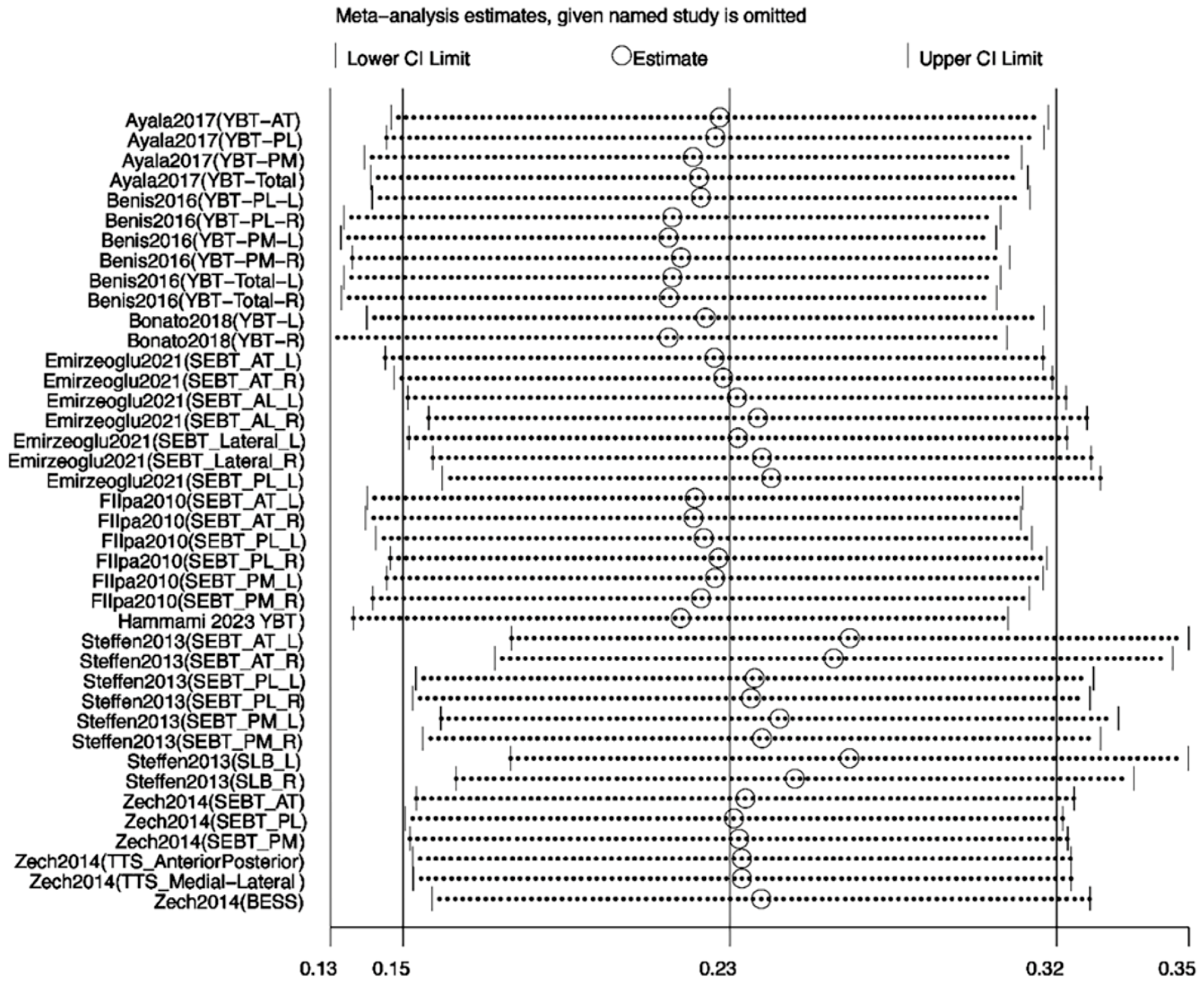
| PICOS Element | Description | Search Terms |
|---|---|---|
| P (Population) | Athletes (professional or amateur) aged ≥11 years, with ≥12 months of training and training ≥ 1 time/week | “athlete*, sport*”,“physical training” |
| I (Intervention) | Integrative neuromuscular training or neuromuscular training | “Integrative neuromuscular training”, “neuromuscular training”, INT, NMT |
| C (Comparison) | Conventional training, other types of training, or no intervention | control*, standard training, “no intervention”, placebo |
| O (Outcome) | Physical performance indicators (e.g., speed, agility, and balance) | performance, speed, agility, balance, “athletic performance” |
| S (Study design) | Randomized controlled trials with a complete intervention protocol | “Randomized controlled trial”, RCT |
| Authors | Sample Size (M/F, E/C) | Age (Years, Mean ± SD) | Type of Athletes | Time/Week | Training Duration | Performance Test | INT’s Components |
|---|---|---|---|---|---|---|---|
| Williams 2023 [25] | 22 (Mixed, 11/11) | 11.4 ± 0.67 | Basketball | 1 | 8 weeks | 10-M ST, CMJ | Functional Movement Training, Dynamic Stability, Coordination Training, Strength Training, Speed/Agility |
| Moliner 2023 [26] | 38 (0/38, 18/20) | - | Football | 3 | 10 weeks | HJ, CMJ, 40-M ST, COD | Mobility, Stability, Strength, Core Stability, Agility |
| Pardos 2024 [23] | 12 (12/0, 6/6) | 13.4 ± 0.36 | Tennis | 2 | 10 weeks | HJ, CMJ, DJ, COD, 20-M ST, MBT | Dynamic Stability, Strength, Plyometric, Coordination, Regeneration |
| Arede 2022 [27] | 30 (30/0, 15/15) | 11.2 ± 0.70 | Football | 2 | 6 weeks | 20-M ST, COD | Dynamic Stability, Strength, Plyometric, Coordination, Regeneration |
| FIlIpA 2010 [28] | 20 (0/20, 13/7) | 15 ± 1.20 | Football | 8 weeks | SEBT | Plyometric, Strength, Dynamic Stability | |
| Italo 2023 [29] | 37 (37/0, 17/20) | 14.31 ± 0.64 | Football | 2 | 8 weeks | HT, SHT, CMJ, 10/20-M ST | Strength and Hold, Balance and Strength, Balance and Stability |
| Emirzeoglu 2021 [30] | 32(32/0, 16/16) | 15–20 | Football | - | - | SEBT | Dynamic Stability, Agility Coordination, Core Control |
| Fernandez 2020 [31] | 29 (29/0, 14/15) | 15.09 ± 6.16 | Tennis | 3 | 8 weeks | 20M-ST, COD, CMJ | Mobility, Core and Trunk Control, Plyometric |
| Michailidis 2023 [32] | 31 (Mixed, 14/17) | 14.3 ± 0.60 | Football | 2 | 5 weeks | 10/20-M ST, SJ, CMJ, COD, IAT | Strength, Plyometric, Core stability, Agility |
| Zhang 2021 [33] | 42 (21/21, 22/20) | 20.13 ± 1.79 | Ballroom dancing | 3 | 10 weeks | Modified-BESS, YBT | Balance |
| Zech 2014 [34] | 30 (30/0, 15/15) | 14.9 ± 3.00 | Hockey | 2 | 10 weeks | SEBT, BESS, TTS | Core Stability, Strength, Balance, Plyometrics |
| Gee 2020 [35] | 20 (0/20, 10/10) | 22.3 ± 2.0 | Gymnastics | 2 | 8 weeks | 20-M ST, CMJ, IAT, QASLS | Plyometrics, Core Stability, Strength, Agility, Regeneration |
| Xiong 2022 [22] | 24 (0/24, 12/12) | 23.2 ± 2.25 | Table tennis | 4 | 8 weeks | VJ, YBT, 30M-ST | - |
| Steffen 2013 [36] | 158 (0/158, 78/80) | 13–18 | Football | 2 | 4–5 months | Single-leg eyes-closed balance, SEBT, SLTH | Agility, Plyometrics, Functional Movement Training, Strength, Balance |
| Fernandez 2018 [18] | 16 (Mixed, 8/8) | 12.9 ± 0.40 | - | - | 5 weeks | 5/10/20M-ST, CMJ, SV, MBT, COD | Plyometrics, Agility, |
| Bonato 2018 [37] | 160 (0/160, 86/74) | 20 ± 2.00 | - | 4 | 8 months | CMJ, YBT | Agility, Strength, Plyometrics, Agility, Speed |
| Benis 2016 [38] | 28 (0/28, 14/14) | 20 ± 2.00 | Basketball | 2 | 8 weeks | YBT | Core Stability, Strength, Balance, Plyometrics, Agility |
| Hammami 2023 [21] | 24 (24/0, 12/12) | 15.5 ± 0.70 | Football | 2 | 8 weeks | YBT, FJT, CMJ, single-leg hop, 30M-ST, COD with ball | Balance, Strength, Agility/Speed |
| Ayala 2017 [39] | 30 (Mixed, 10/20) | 16.8 ± 0.70 | Football | 4 | 4 weeks | Single-leg hop limb, YBT, 10/20M-ST, Agility, VDJ | Strength, Balance, Muscle Control, Core Stability, Speed |
| Subgroup | Number of Studies | Effect Size | 95% CI | p-Value | I2 |
|---|---|---|---|---|---|
| Age | |||||
| <15 years old | 5 | 0.91 | (0.54, 1.27) | 0.543 | 0 |
| ≥15 years old | 17 | 0.62 | (0.41, 0.83) | 0.01 | 50% |
| Mixed | 6 | −0.51 | (−0.78, −0.24) | 0.002 | 73.90% |
| Sex | |||||
| Male | 17 | 0.7 | (0.49, 0.92) | 0.243 | 18% |
| Female | 10 | 0.03 | (−0.14, 0.19) | 0.001 | 85.90% |
| Mixed | 2 | 0.03 | (−0.45, 0.50) | 0.96 | 0 |
| Intervention Time | |||||
| <30 min | 2 | −0.12 | (−0.32, 0.08) | 0.001 | 75.60% |
| ≥30 min | 16 | 0.87 | (0.64, 1.10) | 0.094 | 33.50% |
| Intervention Duration | |||||
| ≤8 weeks | 13 | 0.73 | (0.52, 0.94) | 0.002 | 61.60% |
| >8 weeks | 16 | 0.01 | (−0.15, 0.17) | 0.001 | 67% |
| Intervention Frequency | |||||
| 2 days/weeks | 19 | 0.47 | (0.31, 0.62) | 0.001 | 56.90% |
| ≥3 days/weeks | 9 | −0.15 | (−0.38, 0.08) | 0.001 | 82.10% |
| Subgroup | Number of Studies | Effect Size | 95% CI | p-Value | I2 |
|---|---|---|---|---|---|
| Age | |||||
| <15 years old | 11 | −0.37 | (−0.62, −0.13) | <0.001 | 76.40% |
| ≥15 years old | 7 | −0.62 | (−0.93, −0.31) | 0.754 | 0 |
| Sex | |||||
| Male | 8 | −0.36 | (−0.63, −0.09) | 0.002 | 69.20% |
| Female | 6 | −1.57 | (−1.90, −1.24) | 0.003 | 72% |
| Intervention Time | |||||
| <30 min | 10 | −1.07 | (−1.32, −0.83) | 0.001 | 78.70% |
| ≥30 min | 12 | −0.44 | (−0.69, −0.19) | <0.001 | 72.40% |
| Intervention Duration | |||||
| <8 weeks | 17 | −0.48 | (−0.67, −0.28) | <0.001 | 66% |
| ≥8 weeks | 5 | −0.18 | (−2.17, −1.42) | 0.041 | 59.80% |
| Intervention Frequency | |||||
| 2 days/weeks | 9 | −0.26 | (−0.52, −0.01) | 0.006 | 62.70% |
| ≥3 days/weeks | 12 | −1.33 | (−1.58, −1.08) | 0.001 | 65.90% |
| Subgroup | Number of Studies | Effect Size | 95% CI | p-Value | I2 |
|---|---|---|---|---|---|
| Age | |||||
| ≤15 years old | 6 | 0.25 | (−0.12, 0.63) | <0.001 | 85.90% |
| >15 years old | 5 | −0.73 | (−1.11, −0.35) | <0.001 | 85.30% |
| Sex | |||||
| Male | 7 | 0.06 | (−0.28, 0.39) | <0.001 | 89.40% |
| Female | 3 | −0.43 | (−0.84,−0.02) | 0.336 | 8.4% |
| Intervention Time | |||||
| <30 min | 6 | −0.56 | (−0.86, −0.25) | <0.001 | 81.60% |
| ≥30 min | 7 | 0.17 | (−0.18, −0.53) | <0.001 | 84.70% |
| Intervention Duration | |||||
| ≤8 weeks | 9 | −0.27 | (−0.55, 0.01) | <0.001 | 89.30% |
| ≥8 weeks | 4 | −0.19 | (−0.58, 0.20) | 0.857 | 0 |
| Intervention Frequency | |||||
| 2 days/weeks | 6 | −0.44 | (−0.74, −0.13) | 0.01 | 66.80% |
| ≥3 days/weeks | 7 | 0 | (−0.34, 0.35) | 0.001 | 89.60% |
| Subgroup | Number of Studies | Effect Size | 95% CI | p-Value | I2 |
|---|---|---|---|---|---|
| Sex | |||||
| Male | 14 | 0.05 | (−0.14, 0.25) | <0.001 | 66.80% |
| Female | 22 | 0.25 | (0.15, 0.34) | <0.001 | 84.90% |
| mixed | 4 | 0.75 | (0.36, 1.15) | 0.593 | 0 |
| Intervention Time | |||||
| <30 min | 13 | 0.77 | (0.54, 1.00) | <0.001 | 88.10% |
| ≥30 min | 19 | 0.41 | (0.27, 0.56) | 0.002 | 55.30% |
| Intervention Duration | |||||
| ≤8 weeks | 17 | 1.36 | (1.44, 1.59) | <0.001 | 71% |
| >8 weeks | 16 | 0.07 | (−0.02, 0.16) | 0.367 | 7.5% |
| Intervention Frequency | |||||
| 2 days/weeks | 27 | 0.24 | (0.15, 0.32) | <0.001 | 83.70% |
| ≥3 days/weeks | 3 | 0.75 | (0.36, 1.15) | 0.0005 | 95.90% |
Disclaimer/Publisher’s Note: The statements, opinions and data contained in all publications are solely those of the individual author(s) and contributor(s) and not of MDPI and/or the editor(s). MDPI and/or the editor(s) disclaim responsibility for any injury to people or property resulting from any ideas, methods, instructions or products referred to in the content. |
© 2025 by the authors. Licensee MDPI, Basel, Switzerland. This article is an open access article distributed under the terms and conditions of the Creative Commons Attribution (CC BY) license (https://creativecommons.org/licenses/by/4.0/).
Share and Cite
Chen, B.; Deng, L.; Liu, Y.; Deng, X.; Yuan, X. The Effect of Integrative Neuromuscular Training on Enhancing Athletic Performance: A Systematic Review and Meta-Analysis. Life 2025, 15, 1183. https://doi.org/10.3390/life15081183
Chen B, Deng L, Liu Y, Deng X, Yuan X. The Effect of Integrative Neuromuscular Training on Enhancing Athletic Performance: A Systematic Review and Meta-Analysis. Life. 2025; 15(8):1183. https://doi.org/10.3390/life15081183
Chicago/Turabian StyleChen, Baili, Lin Deng, Yuhang Liu, Xiaojing Deng, and Xiaoyi Yuan. 2025. "The Effect of Integrative Neuromuscular Training on Enhancing Athletic Performance: A Systematic Review and Meta-Analysis" Life 15, no. 8: 1183. https://doi.org/10.3390/life15081183
APA StyleChen, B., Deng, L., Liu, Y., Deng, X., & Yuan, X. (2025). The Effect of Integrative Neuromuscular Training on Enhancing Athletic Performance: A Systematic Review and Meta-Analysis. Life, 15(8), 1183. https://doi.org/10.3390/life15081183




